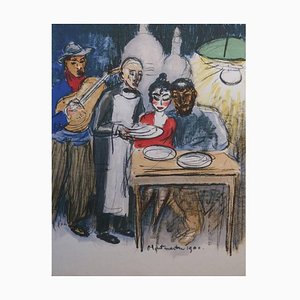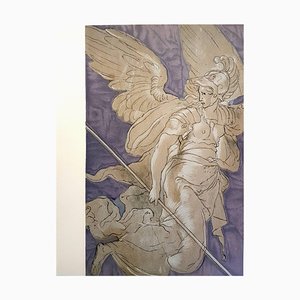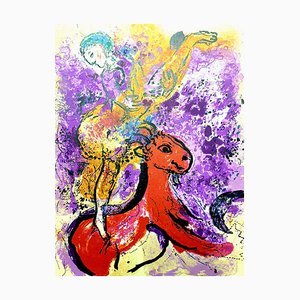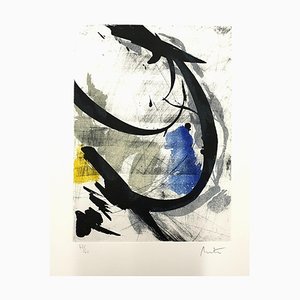Joan Miro Miro Original Abstract Lithograph Artist: Joan Miro Medium: Original lithograph on Rives vellum Portfolio: Miro Lithographe V Year: 1981 Edition: 5000 Image Size: 10'' x 13'' Sheet Size: 10'' x 13'' Reference: Mourlot 1256 Biography Joan Miró i Ferrà (April 20,1893 – December 25,1983) was a world renowned Spanish Catalan painter, sculptor, and ceramist who was born in the sea port city of Barcelona. Miro was the son of a watchmaking father and a goldsmith mother, he was exposed to the arts from a very young age. There have been some drwaings recovered by Miro dating to 1901, when he was only 8 years old. Miro enrolled at the School of Industrial and Fine Arts in Barcelona until 1910; during his attendance he was taught by Modest Urgell and Josep Pascó. After overcoming a serious bout of typhoid fever in 1911, Miro decided to devote his life entirely to painting by attending the school of art taught by Francesc Galí. He studied at La Lonja School of Fine Arts in Barcelona, and in 1918 set up his first individual exhibition in the Dalmau Galleries, in the same city. His works before 1920 (the date of his first trip to Paris) reflect the influence of different trends, like the pure and brilliant colors used in Fauvism, shapes taken from cubism, influences from folkloric Catalan art and Roman frescos from the churches. His trip to Paris introduced him to and developed his trend of surrealist painting. In 1921, he showed his first individual exhibition in Paris, at La Licorne Gallery. In 1928, he exhibited with a group of surrealists in the Pierre Gallery, also in Paris, although Miró was always to maintain his independent qualities with respect to groups and ideologies. From 1929-1930, Miró began to take interest in the object as such, in the form of collages. This was a practice which was to lead to his making of surrealist sculptures. His tormented monsters appeared during this decade, which gave way to the consolidation of his plastic vocabulary. He also experimented with many other artistic forms, such as engraving, lithography, water colors, pastels, and painting over copper. What is particularly highlighted from this period, are the two ceramic murals which he made for the UNESCO building in Paris (The Wall of the Moon and the Wall of the Sun, 1957-59). Joan Miro UNESCO Mural- “The Moon and The Sun” It was at the end of the 60´s when his final period was marked and which lasted until his death. During this time, he concentrated more and more on monumental and public works. He was characterized by the body language and freshness with which he carried out his canvasses, as well as the special attention he paid to material and the stamp he received from informalism. He concentrated his interest on the symbol, not giving too much importance to the representing theme, but to the way the symbol emerged as the piece of work. Miro had a very eccentric style that is the embodiment of his unique approach to his artwork. In 1976 the Joan Miró Foundation Centre of Contemporary Art Study was officially opened in the city of Barcelona and in 1979, four years before his death, he was named Doctor Honoris Causa by the University of Barcelona.
Joan Miro Miro litografia astratta originale Artista: Joan Miro Medium: Litografia originale su pergamena Rives Portfolio: Miro Lithographe V Anno: 1981 Edizione: 5000 Dimensione immagine: 10'' x 13'' Dimensione foglio: 10'' x 13'' Riferimento: Mourlot 1256 Biografia Joan Miró i Ferrà (20 aprile 1893 - 25 dicembre 1983) è stato un pittore, scultore e ceramista catalano di fama mondiale, nato nella città portuale di Barcellona. Figlio di un padre orologiaio e di una madre orafa, Miro fu esposto alle arti fin dalla più tenera età. Sono stati recuperati alcuni disegni di Miro risalenti al 1901, quando aveva solo 8 anni. Miro si iscrisse alla Scuola di Arti Industriali e Belle Arti di Barcellona fino al 1910; durante la sua frequenza ebbe come insegnanti Modest Urgell e Josep Pascó. Dopo aver superato un grave attacco di febbre tifoidea nel 1911, Miro decise di dedicarsi interamente alla pittura frequentando la scuola d'arte di Francesc Galí. Studia alla Scuola di Belle Arti La Lonja di Barcellona e nel 1918 allestisce la sua prima mostra individuale nelle Gallerie Dalmau, nella stessa città. Le sue opere prima del 1920 (data del suo primo viaggio a Parigi) riflettono l'influenza di diverse tendenze, come i colori puri e brillanti usati nel fauvismo, le forme prese dal cubismo, le influenze dell'arte folclorica catalana e gli affreschi romani delle chiese. Il suo viaggio a Parigi lo introdusse e sviluppò la sua tendenza alla pittura surrealista. Nel 1921, espose la sua prima mostra individuale a Parigi, alla galleria La Licorne. Nel 1928, espose con un gruppo di surrealisti nella Galleria Pierre, sempre a Parigi, anche se Miró doveva sempre mantenere le sue qualità indipendenti rispetto ai gruppi e alle ideologie. A partire dal 1929-1930, Miró comincia ad interessarsi all'oggetto in quanto tale, sotto forma di collage. Una pratica che lo porterà a realizzare sculture surrealiste. In questo decennio appaiono i suoi mostri tormentati, che danno luogo al consolidamento del suo vocabolario plastico. Sperimentò anche molte altre forme artistiche, come l'incisione, la litografia, i colori ad acqua, i pastelli e la pittura su rame. Di questo periodo si evidenziano in particolare i due murales in ceramica che realizzò per il palazzo dell'UNESCO a Parigi (The Wall of the Moon e the Wall of the Sun, 1957-59). Murale UNESCO di Joan Mirò - "La Luna e il Sole" È alla fine degli anni 60 che si segna il suo ultimo periodo, che durerà fino alla sua morte. Durante questo periodo si concentrò sempre più su opere monumentali e pubbliche. Si caratterizzò per il linguaggio corporeo e la freschezza con cui eseguiva le sue tele, così come l'attenzione speciale che prestava alla materia e il timbro che riceveva dall'informalismo. Concentrava il suo interesse sul simbolo, non dando troppa importanza al tema rappresentativo, ma al modo in cui il simbolo emergeva come opera. Mirò aveva uno stile molto eccentrico che è l'incarnazione del suo approccio unico alla sua opera d'arte. Nel 1976 fu ufficialmente aperto nella città di Barcellona il Centro di Studi di Arte Contemporanea della Fondazione Joan Miró e nel 1979, quattro anni prima della sua morte, fu nominato dottore honoris causa dall'Università di Barcellona.




















Contattaci
Fai un'offerta
Abbiamo notato che sei nuovo su Pamono!
Accetta i Termini e condizioni e l'Informativa sulla privacy
Contattaci
Fai un'offerta
Ci siamo quasi!
Per seguire la conversazione sulla piattaforma, si prega di completare la registrazione. Per procedere con la tua offerta sulla piattaforma, ti preghiamo di completare la registrazione.Successo
Grazie per la vostra richiesta, qualcuno del nostro team vi contatterà a breve.
Se sei un professionista del design, fai domanda qui per i vantaggi del Programma Commerciale di Pamono